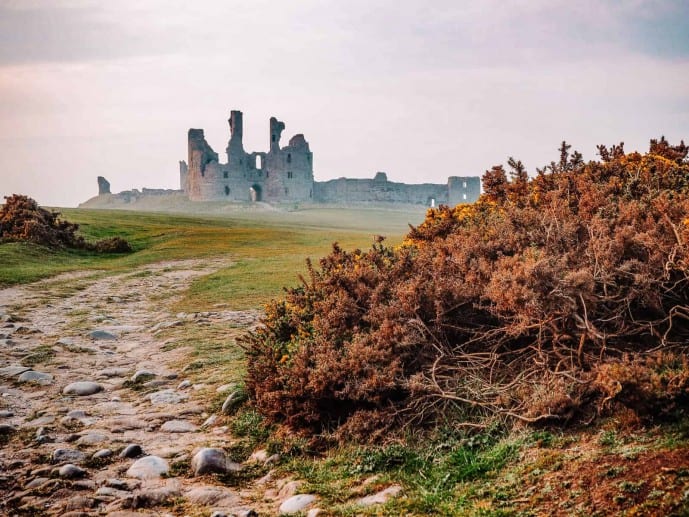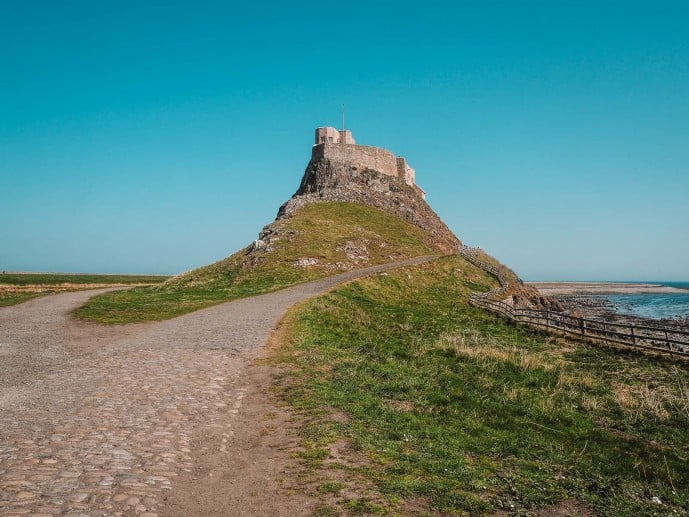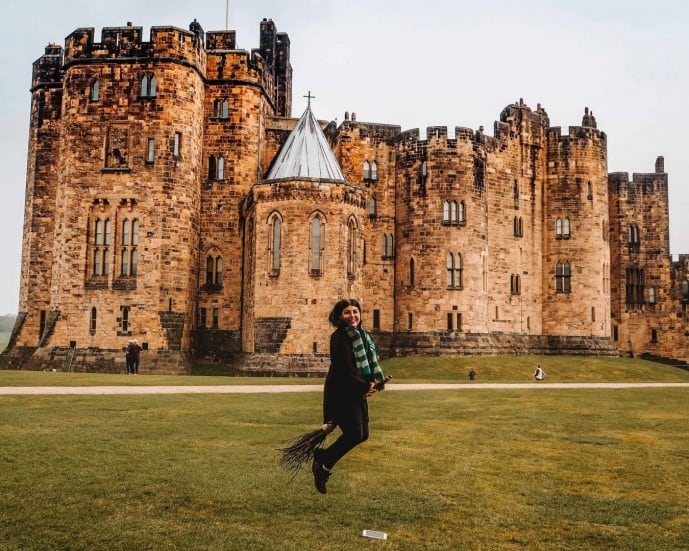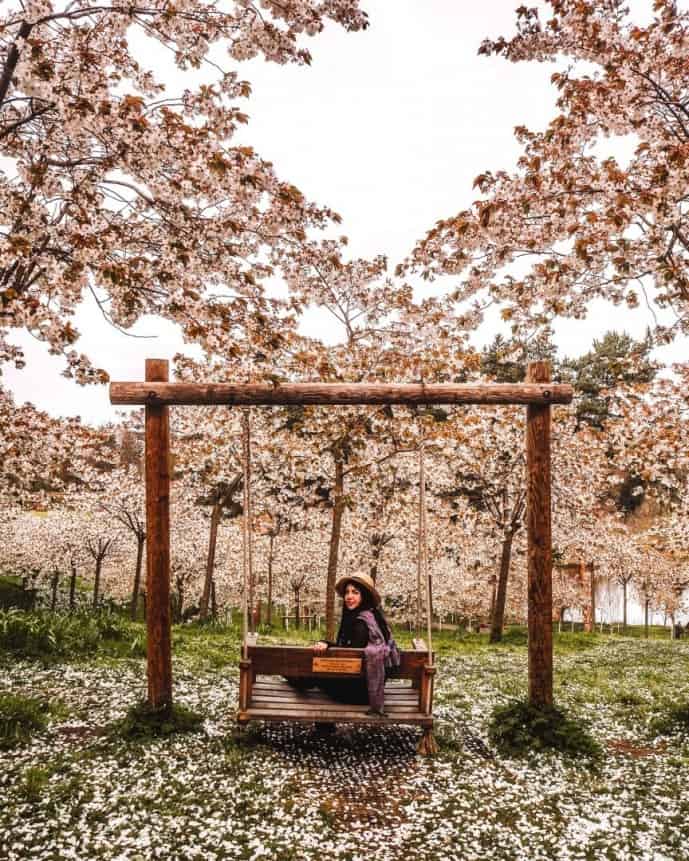This post may contain affiliate links. Please see my disclosure policy for details.
Looking back, the Craster to Dunstanburgh Castle walk in Northumberland was truly a highlight of my trip there!
What could be more perfect than strolling along the rugged coastline at sunset and heading towards an enchanting ruined castle on the horizon?!
I decided to take the Craster to Dunstanburgh Castle route and I have to admit I wasn’t expecting much. But, I was blown away.
Not only was being by the sea good for my soul, but it also blew away the cobwebs and I fell in love with the endless beguiling scenery.
It’s easily one of Northumberland’s prettiest and most atmospheric trails, perfect for photography and history lovers and I would highly recommend that you add it to your itinerary.
If you did need more convincing, here’s a complete guide for walking from Craster to Dunstanburgh Castle in Northumberland!

Dunstanburgh Castle history
Of course, Dunstanburgh Castle wasn’t always a ruin on the coast. Dunstanburgh means ‘the fort’ (burgh) ‘of the town’ (dun) ‘by the rock’ (stan).
In its past life, it was an impressive defence fortification on the coastline. The mere sight of it projected an air of dominance.
The castle was built back in the 14th century by Thomas, the Earl of Lancaster, between 1313 and 1322. He was an extremely powerful Baron under King Edward II, who was his cousin, and he was the second richest nobleman in England at the time.
It is believed that Thomas of Lancaster built the castle away from Edward’s forces in the south.
To say that these two had a turbulent relationship would be an understatement!
Unfortunately, it didn’t end well for the Baron when he tried to lead a rebellion against the King. He was arrested for treason! It was an embarrassing trial and he was beheaded at his own castle in Pontefract.

Later the castle was modernised by John of Gaunt, who was Edward III’s fourth son, in 1380.
It then went onto play a huge role in the Lancastrian War of the Roses. It was John of Gaunt’s son, Henry IV, who claimed a right to the throne and became king.
By the Middle Ages, it fell into disrepair and was left to rot.
Despite its transformation as a ruin, its beauty was never lost. Famous painters like JMW Turner found romanticism in the disrepair and painted an inspiring portrait.
Even today, photographers are inspired by this beauty spot. It has a certain mood to it.
Personally, I have a thing for ruined castles. I think they’re so romantic! Today, it’s owned and managed by English Heritage.

Is Dunstanburgh Castle haunted?
A castle this old is sure to have its fair share of spirits around. Apparently, Thomas of Lancaster still haunts the castle bearing the same expression as the one when he lost his head.
Also, it’s said that Margaret of Anjou, wife of King Henry VI, is seen on the grounds.
However, the most famous of the ghosts here is said to be Sir Guy, an ancient knight!
He stumbled upon Dunstanburgh Castle one day and was caught up in a terrible storm. He decided to take shelter under the gatehouse.
All of a sudden a gruesome figure dressed in white told him of where he could find his ‘beauty bright’. The figure led him up a staircase where a hundred knights were sleeping with their horses.
In the centre of the room lay the most beautiful woman that Sir Guy had ever seen in a crystal casket. But, on either side of her casket were two serpents. One held a sword and the other a horn.

He knew he had to choose one to rouse her, but which one? He eventually chose the horn and blew it. But, all of the knights rushed towards him to kill him.
Guy found himself fading away and the figure said ‘Now shame on the coward who sounded a horn, and the knight who sheathed a sword.’
When Guy awoke, he found himself under the gatehouse again. He became obsessed with trying to find this sleeping maiden and looked all over the castle.
Unfortunately, she would never be found and he would die a broken old man.
Sometimes, when the waves are crashing on the shores and the wind howls through the cracks, a forlorn Guy can be found looking for his lost love on the clifftops. Keep a wary eye!

Where is Dunstanburgh Castle in Northumberland?
Dunstanburgh sits on a remote headland in between the villages of Craster and Embleton on the Northumberland coast in England.
It’s located around 8 miles north-east of Alnwick and is in an Area of Outstanding Natural Beauty. So, you already know that this walk is going to be beautiful!
Can you drive to Dunstanburgh Castle?
No, the only way that you can reach the castle is by walking to it along the rugged coastal path.
This is not an accessible walk as the path will mostly be on the grassy headland. You’ll be walking to it for just over 1 and a half miles one way at a minimum.
If you’re looking for where to park for Dunstanburgh Castle, the easiest spot is to park up in the National Trust car park in Craster.
From here, you can easily access the walking trail by Craster Harbour. This is the shortest route.
There is also a limited amount of parking spaces in Dunstanburgh Golf Club in Embleton too but this route will be much longer.
Bus to Dunstanburgh: The Arriva service X18 will take you to Craster village. You can then alight here and walk along the coastal path.

How long is the Craster to Dunstanburgh Castle walk?
The Craster to Dunstanburgh Castle walk route is around 1.3 miles and should take you roughly 25 – 30 minutes one way.
But, this completely depends on your walking speed and whether you want to take photos! Personally, this walk took me more like 45 minutes as I kept stopping to snap the views.
I would allow 90 minutes to two hours to complete the whole loop from Craster and even longer if you plan to visit the castle.
If you’re heading from Embleton to Dunstanburgh, this walk will take you slightly longer. It’s 2.2 miles and it will take 45 minutes one way at a minimum.

Tips and warnings before you set out
- Accessibility – this walk is mostly on relatively flat ground but I don’t feel that it’s for everyone. The path is mainly grassy, uneven and towards the end there is an incline on the headland to reach the castle. Just be mindful of this as it’s a long walk without any assistance to you. There’s barely any benches or break points. The castle itself is a different story with ample accessibility, It’s just getting there first! See here for more details.
- Sheep and their poop – There are a lot of sheep grazing here, so be mindful of that while you’re out walking. If they have young in the spring, they can be seriously overprotective. There is also a LOT of dung around.
- Is Dunstanburgh dog friendly? YES, although the National Trust do own a lot of the area, English Heritage run the castle and they allow dogs. Just keep them on a lead on the walk because of the sheep grazing in the area.

What to wear for the Craster to Dunstanburgh walk and a quick packing list
- A good pair of shoes – this walk is mostly flat but you will find you’ll be walking on a lot of uneven ground. It can be muddy in bad weather, especially on the grass and headland! So, bring a good pair of walking shoes. This is no place for stilettos.
- Bring an extra layer – This walk will see you walking along the coastline and it can get extremely windy even in good weather. So, pack an extra layer or a coat and hat if it’s a chilly day.
- Prepare for rain – This is the North of England and it is known for its wet weather! So, I would bring something to protect you from elements should it pour down. The area is completely exposed.
- Pack some water and snacks – there is a small shop inside Dunstanburgh Castle if the castle is open. But, if not, best to bring some supplies as there’s nothing out on the headland. It’s very remote.
- Camera and tripod – if you’re planning to capture the castle (I mean why wouldn’t you?!), It’s best to bring your gear! At sunset a tripod would be ideal for the best for resolution. Even if you’re not into photography in a big way, you don’t want to miss capturing this.

When is the best time to visit Dunstanburgh Castle?
Personally, although it is nice to visit Dunstanburgh Castle when it’s open, sunset is the best time to visit.
If it’s a good weather day, the sky changing colours here behind the ruined castle as you walk over to it is just gorgeous!
For photography, this is also the best time due to the soft lighting and the chance of different colours and hues in the sky.
Saying that, if you were thinking of visiting the castle during the day, there isn’t really a ‘bad’ time to visit.
Dunstanburgh doesn’t see as many crowds as the likes of Bamburgh or Alnwick Castle because of the walk that it takes to get here.

Step by step instructions for the Craster to Dunstanburgh Castle walk
For those that would like more detailed walking instructions (I know I do!), I’ll go through each step of the way below.
This is for the Craster to Dunstanburgh Castle walk as this is the route I took. It will be a lot different for the Embleton route.
1. Park up at the National Trust Craster car park
As you enter Craster village, you’ll need to locate the visitor car park that sits on the edge of it.
Parking inside Craster village itself is restricted to residents and those staying in one of the hotels or cottages.
Luckily, the car park is only 150 metres away from Craster Harbour, so you won’t be walking far to get to the access point for the walk.
The car park has 60 spaces and the minimum charge for parking is £2.
It is FREE after 6 pm though which is perfect timing for those wanting to watch the sunset here!

2. Head around to Craster Harbour on Dunstanburgh road
Once you’ve parked up in the car park, you’ll need to head on down towards Craster Harbour which is a pretty spot in itself.
It’s a small place that has seen working fishermen here for centuries with the protection of Little Carr and Muckle Carr cliffs.
The working harbour we see here today though is from 1906 by The Craster family.
They built it in memory of Captain John Craster who passed in the Tibetan campaign.
There are lots of places that you can relax, take in the views or see the fishing nets and crabbing boxes.
You could also pop over to the Jolly Fishermen if you fancied a pint or a meal before or after your walk!

3. Walk North, through the entrance gate and move forward onto the coastal path
From Craster Harbour, you’ll need to head through the North kissing gate on Dunstanburgh Road.
You’ll pass by some houses until you reach an entrance for the walk to Dunstanburgh castle.
From here, you’ll be heading pretty much straight on. Eventually, the castle ruins will come into sight on the coastline.
There will be a lot of gates here that you need to walk through and these will need to be kept closed to protect wildlife. Some even had chains on them but don’t worry, you are allowed through!
Along the way, you can see the rugged coastline and you should keep your eyes peeled for wildlife.
Seals like to hide here in the surf or they may be sunning themselves on the rocks.
This part of the walk is where you’ll get the best photos of Dunstanburgh Castle with it appearing over the headland on the sea.

4. Visit Dunstanburgh Castle ruins
As you walk towards the ruins, they gradually become bigger and bigger. Then, when you finally get here, you can see that the castle used to be humungous!
Despite it being a ruin now, once upon a time, it was actually one of the largest and grandest fortifications in all of Northern England.
If you walk around the castle grounds, it will almost seem unfathomable that such a large castle used to dominate the area.
From recent excavations, it used to stretch much larger than the area we can visit today.
If you were curious and wanted to see a full archaeology report from English Heritage they have one here.
The ruins we can see today though are definitely worth visiting.
English Heritage always do a great job of providing lots of information and sketches of what it would have looked like years ago!

Dunstanburgh Castle opening times & prices
If you were interested in visiting the castle, it’s open on weekends in the low season from 9.30 am – 5 pm. But, remains open daily during the high season and school holidays.
Always check opening times before you visit.
Tickets for Dunstanburgh Castle are £6.50 an adult and £3.90 a child. Family tickets are available. Both English Heritage and National Trust members get in FREE. Make sure to bring your card with you!
5. Turn back or walk over to Low Newton-by-the-Sea
From here, you can either walk back to Craster on the same route, or you can carry on over to Embleton village and Low Newton-by-the-Sea.
The walk will be around 5 miles one way and will take around 4 hours to complete the whole loop back to Craster.
Low Newton-by-the-Sea is a gorgeous civil parish located on the coast. Here you can walk along the sandy beach at low tide and get incredible views of the castle ruin from here too!

Dunstanburgh Castle photography tips
I’m not a professional photographer by any means but I do love to take photos, as you can probably tell.
So, here are some of my top tips for capturing the castle on your visit;
- Visit at sunrise or sunset – a photographer’s secret is to visit the castle when the lighting is softest. Either at gold or blue hour, just before sunrise or around the later part of sunset. This is the best chance for those lovely colours to come through in the sky and means far fewer crowds.
- Use the headland for texture – I found the best compositions were actually way before I reached the castle ruins themselves. Walking along the jagged coastline has a lot of lovely angles where you can bring the coast and the sea into the foreground of your shot. It creates layers and it will just look much more appealing! Plus, if the waves are crashing on the shore it has a flair of the dramatic.
- A tripod is best for low light – If you are planning to take photos of the castle once the sun has lowered, it’s always best to have a tripod for crisp images. Any movement, even if it occurs naturally from your finger pushing the shutter, will create a blur. You don’t want that!
- Watch your equipment – if you do plan on using a tripod, keep hold of it or plant it firmly in the ground! The headland is exposed and the coastline is breezy. I’ve learned the hard way of my camera breaking from freak wind!
Where to stay near Dunstanburgh
- Harbour Lights – A cosy B&B that sits right in the heart of Craster Village. The property and rooms have a delightful view of the sea. Click for rates.
- Craster Tower – How does staying in a 14th-century property sound? You’ll get the whole top floor of the manor house built around a Pele Tower. It’s been completely refurbished. Click for details.
- Dunstanburgh Castle Hotel – A historic property set in Embleton, you can easily base yourself here to explore the area! As well as boutique rooms they have self catered cottages for rent. Enquire here.
Looking for more places to visit in Northumberland?
So, once you’ve finished this amazing walk, where next? Well, there are plenty of incredible places to explore in the county of Northumberland!
From coastal villages, mysterious tidal islands, garden estates and ancient castles. You’ll be spoiled for choice.
Here are some my favourites;
Bamburgh Castle
Bamburgh is a popular town on the coastline of Northumberland known for its historic Bamburgh Castle. It has a dramatic position on the beach.
There have been settlements here since 10,000 BC during the Iron Age and following that, the Roman era.
What we see today, really grew as a middle-age fortification in the Norman Era. It was seized in the Lancastrian War of the Roses in the 15th century!
Eventually, it gave up its previous life as a stronghold and it was purchased by Lord Armstrong in 1894. He developed it into his personal family home and opened it up to the public as a tourist attraction in the mid 1900s.
As well as having bucket loads of history with its state rooms, castle towers and dungeons, it’s also meant to be haunted.
Staff have seen sightings of a Pink Lady, Green Jane and Dr John Sharp. So, be careful if you’re visiting alone or staying here!
I recently visited Bamburgh Castle at Christmas and it’s beautiful decorated for the festive season.
This is also the location of Uhtred’s Bebbanburg in The Last Kingdom on Netflix! Click here to read my fan guide.

The Holy Island of Lindisfarne
There are plenty of tidal islands off the coast of Great Britain but none so magical as the Holy Island of Lindisfarne.
Not many can claim the title of the first place that the Vikings invaded England!
It’s only accessible by a tidal causeway at low tide and you MUST check the tide timings before you go. Every year the UK hear of cars getting stuck on the news!
On the island itself, you can wander around the gorgeous harbour village, visit the ruined Lindisfarne Priory of the iconic Lindisfarne Castle.
There are also other islands and beaches to access at low tide like St Cuthbert’s Island.
Don’t forget to pop into St Aidan’s winery to try the legendary Lindisfarne Mead. Or, if you’re feeling peckish, there are plenty of coffee shops and pubs for food options.
Click here to read my complete Lindisfarne guide on the top things to do here

Alnwick Castle & Gardens
Fans of Harry Potter may just lose it at Alnwick Castle. It was a filming location and scenes filmed here include the famous broomstick flying lessons.
If you wanted to have a go at flying yourself, you can even learn with their broomstick lessons that take place on select days of the year.
The Alnwick Garden is also a must-visit and has some incredible flower displays and some poisonous ones too.
When I visited, I got to explore the largest white cherry blossom festival in the world! It was completely magical with blossoms flying everywhere.
You can also learn about plants that kill in their poison garden or dine in their award-winning TreeHouse restaurant that looks like something out of a fairytale. Tip: book well in advance!
Alnwick Town is also worth exploring and you can make a stop at the magical Barter Books.


Ford & Etal
The three areas of Ford, Etal and Heatherslaw Mill were notoriously feudal in these parts on the borders of Scotland. Each village had its own laird, castle, mill, farms and churches.
If you were from Ford and were caught conspiring with someone from Etal or Heatherslaw, it would be bad news for you. It was extremely strict!
You wouldn’t think it nowadays when you’re driving through the countryside and visiting these villages. It’s now just one peaceful retreat in Northumberland, but with a big history to tell.
You can visit Etal Castle that featured heavily in the bloody Battle of Flodden. The battlefield is just nearby the village.
Ford is home to the Lady Waterford Hall and inside it, you can see the most beautiful frescos.
Or, visit Heatherslaw Mill to see how people used to make flour and ride their unique heritage steam railway.
Click here to read my complete travel guide on this hidden gem in Northumberland


